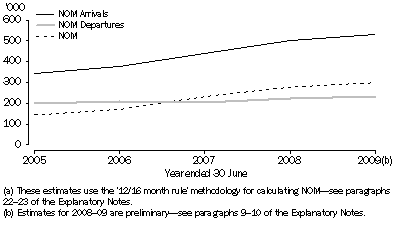NOM arrivals and NOM departures
Based on the current methodology (12/16 month rule - see Glossary), NOM is calculated by counting incoming international travellers who stay in Australia for 12 months or more and have been added to the population (NOM arrivals) and counting those outgoing international travellers (Australian residents and long-term visitors to Australia) who stay away from Australia for 12 months or more and have been subtracted from the population (NOM departures). At the national, level NOM is traditionally positive, with more NOM arrivals than NOM departures, thereby providing a net increase and adding people to Australia's population each year.
Using data based on the current methodology, over the five years 2004-05 to 2008-09 (i.e. all NOM data currently available using the 12/16 month rule), NOM has increased by 110% (from a net of 142,500 to a net of 298,900 persons) with NOM arrivals increasing by 55% (from 341,400 to 529,700 persons) and NOM departures increasing by 16% (198,900 to 230,800 persons) as seen in Figure 3.2. The recent large increases in NOM arrivals has not been offset by similar increases in NOM departures thereby making a large increase to the net of overseas migration. The large increases in NOM arrivals have been mainly due to the large increase in temporary visa arrivals such as international students, business long-stay (subclass 457), working holiday makers and other long-term visitors which is discussed later in this chapter (see Figures 3.12 to 3.18). Therefore, the increase in the net of overseas migration during recent years is primarily due to the increase in temporary visa arrivals.
3.2 Components of NOM(a)
- Australia

 Print Page
Print Page
 Print All
Print All
 Print Page
Print Page
 Print All
Print All